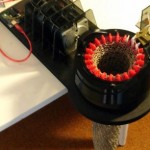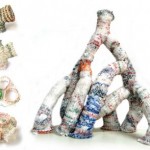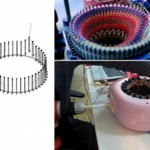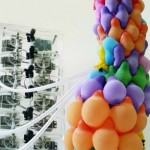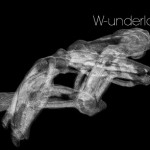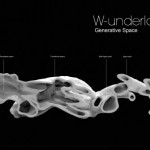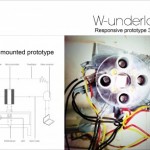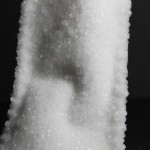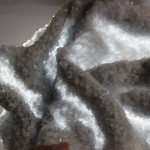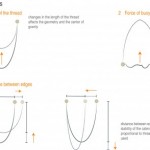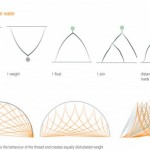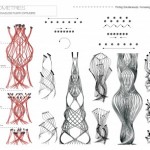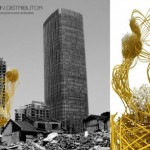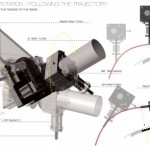MAA Students: Melat Assefa (Ethiopia), Joao Nuno Palaio Albuquerque (Portugal), Brian Peters (USA)
Studio Instructor: Marta Malé-Alemany
Technical Support: Victor Viña
Studio Assistant: César Cruz Cázares
Category Archives: Digital Tectonics
(Fab)Bots 1.0: Dreamweaver
(Fab)Bots 1.0: Pneumorphisis
MAA Students: Natalija Boljsakov, Carlos Naranjo, Brian Miller
Studio Instructor: Marta Malé-Alemany
Technical Support: Victor Viña
Studio Assistant: Cesar Caceres
(Fab)Bots 2.0: W-underland
MAA Students: Mohamad Ghamlouch (Lebanon),Morten Bulow (Denmark), Marko Vukovic (Serbia)
Studio Instructor: Marta Malé-Alemany
Technical Support: Victor Viña
Studio Assistant: Brian Peters
Project Summary:
The ecological and collective intelligence through which nature operates has stimulated a new approach to architectural design & construction (1). This multidisciplinary approach draws largely on existing synergies between biology & computer science. In particular, the study of self-evolving biological systems & organisms (2) & the inherent interrelation of architecture to its natural environment have affected current architectural thinking by putting the emphasis on the generative process of the structure, rather than the end product itself. Key biological concepts such as adaptation,homeostasis,emergence & self organization may be translated in architectural practice,in order for the man made artificial structure to be ‘alive’, that is,to achieve equilibrium with its natural environment. Lamarck’s concept of adaptation ensures the fitness of a system by causing changes as a response to environmental pressure, but also allows for the fit system-organism to influence its environment in turn. Self-organization characterizes the properties of a system such as the continual adaptation to a changing environment & the strong aptitude to restore itself without centralized control or supervision. Self-organizing parts of the system or else autonomous agents carry out simple local rules without the insight that they perform a global task or that they participate in global organization.
In architecture, we could consider a homeostatic and self-organizing structure as a structure which adapts dynamically to the changing environmental conditions;a living system,a ‘breathing’ organism in equilibrium with its ecological environment. The main research question this project addresses is what innovative techniques of design, construction and materials could prospectively be developed and eventually applied and sustain man made architectural systems which are mostly adaptive, homeostatic and self-controlled, without option to a vast supply of materials and peripheral services.
(Fab)Bots 2.0: Kry(n)stallation
MAA Students: Diego Lopez Ibarra (Mexico), Gamze Gunduz (Turkey), Viraat Kumar (India)
Studio Instructor: Marta Malé-Alemany
Studio Assistant:Brian Peters
Technical Expert: Victor Viña
Project Summary:
Kry(n)stallation is a construction process that mixes two wasted phenomenons found in nature in order to model and rigidify inhabitable temporary spaces of low cost and reusable materials. Floatation and crystallization.
It’s geometrical shaper method takes advantage of the force of floatation on lineal soft elements (like threads or ropes) in order to lift some parts and sink other ones, achieving a desired form. These spaces are dictated by the position of the threads on a base and the placing of some punctual items that improve or reduce the buoyancy effect on the thread, such floats and weights.
The second natural process is the stiffening of those threads and it happens thanks to the particles of floating crystals in the solution, triggering the growth of crystals on the submerged group of threads under a supersaturated solution. Crystals would cover each thread in a specific period of time, merging the crystals layer of one thread to the closest layer, creating a single crystal “stone”.
This supersaturated solution can be produced under controlled conditions (like borax or sugar) or can be simply find on site in the Dead Sea owning to the fact it’s waters contains a particular amount of salt that crystallizes
Before the submersion of the threads a pre-treatment of them is done, a half automated, half manual.
The computerized part prints an “instructive” on the thread itself and on the base where it will be placed. This information is generated on a computer and is communicated by a kit of portable devices described next.
A machine colors with dots where the floats, weights and connections to other threads should be placed on the thread. A fourth color indicates the initial and final edges of the thread that should be connected to the frame or to other thread. These edges are labeled by a small label printer, that relates the threads to a frame printed on a continuous paper printer and pasted on a solid surface (like wood).
The dipping technique of the group of threads would depend of the supersaturated solution (a manufactured tank, a site filled with the solution or the Dead Sea) and will result, after the crystallization, in a temporary resistant structure. The material can be reused after the melting, even the crystals.
(Fab)Bots 3.0: PET Flakes
MAA Students: Akram Ahmed (Sudan) , Christiana Vlanti (Greece), Pavlos Bakagiannis(Greece), Theodoros Grousopoulos (Greece)
Studio Instructor: Marta Malé-Alemany
Studio Assistant: Jordi Portell,Miquel Lloveras
Technical Experts: Santiago Martin, Guillem Camprodon, Santiago Martín González
Project Summary:
Emergent ecological problems require a different approach as far as the architectural practice is concerned. As architecturecannot be seen independently from its environment-and especially today more than any time in the past-the design, the material and the actual architectural process must comply with and adapt to the occurred environmental needs.Triggered by the global issue of plastic waste and its consequences, the project seeks to contribute to the literal purge of the problem. Instead of using an aggregate raw material, it exploits the potential of a material coming immediately from post-consumer waste, approaching through an innovative manner. Thus, PET plastic coming straight from garbage are used in order to explore the relation between matter, design and technology. Its abundance and chemical and physical properties were crucial for its choice. The purpose of this project is to investigate a range of design and production methods using PET flakes by setting up digital work flows that are constantly fed with data by the material system. After a series of experiments to fully understand the behavior of the raw material, the project develops structure methodologies using sensor-based generative design methods connected to customized fabrication hardware. The ultimate goal of this research is to propose application of PET in architecture allowing a potential construction of structures on site.
-Supporting Material: The structures are created without any need of a cast. The same material works is both structural and supporting.
- Catalyst: No catalyst is used for the solidification process. The solidification of the material happens through the exposure to the environment.

